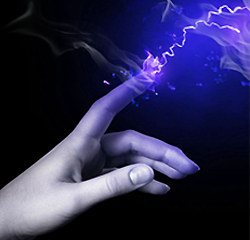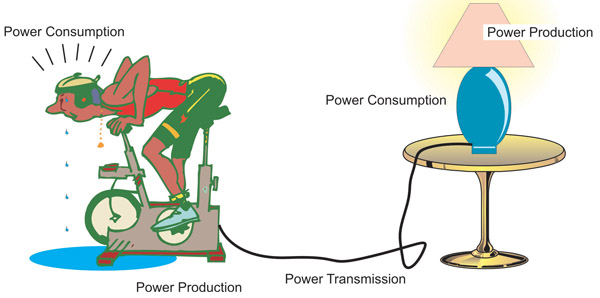
Let’s get the terminology in place. Energy is measured in joules. It can just sit captive (potential energy) or it can be put into motion (kinetic energy), be it water turning a turbine or a husband taking out the trash.
Work is the result of using a force to move something over a distance, so work is equal to force times distance. Power is the rate of doing work.
That’s an important point, and we will come back to it. Power can be rated in watts, with one watt being equal to one joule per second. So for power to be generated, work must be done for a period of time. If the time span is reduced, so is the generated power. Remember that when you look at specs such as “instantaneous peak power.”
You As Power Generator
A good way to get a better feel for power generation and consumption is to consider a generator that we all possess—our bodies. We humans consume energy in the form of food, store energy in the form of fat, and then burn it up in the course of day-to-day living. We convert energy from one form to another.

It is a process that we continually experience but rarely measure, other than the occasional reluctant glance at the bathroom scales, which provides a composite view of intake vs. output since the last glance.
Let’s attempt to measure power by hopping on an exercise bike—one that reads in watts, but could just as well read in calories, cycles/min, heart rate, or even body temperature.
There are many ways to measure power, and most methods are just estimates. Start pedaling and watch the display. If you work pretty hard you can get it up to 100 joules per second (100 watts). So as you pedal, you are generating 100 watts continuous average power as you pump the pedals.
If you do this for one hour, you have generated 100 watt-hours. If your bike were hooked to the power grid you could sell your hour’s effort to the utility company for about ten cents, assuming that they can convert all of the generated power into electricity.
After observing your efforts for a period of time, we could ascribe a rating that indicates how well you perform as a generator. The rating would indicate how much power you can produce on a continuous basis. The rating could be in watts, but there are other possibilities.
We could compare you to a horse and specify your abilities in horsepower. One horsepower equals 746 watts, which would put your power rating at about 0.075 horsepower. So it would take about 10 people to generate as much power as one horse, which is why a good horse (or the modern equivalent, a tractor) might be considered of greater value than a person, at least when it comes to farm work.
A person who could maintain 100 watts of power generation longer than another would be considered a more powerful source. If we exclude the time metric, then a meaningful comparison between two power sources would not be possible.If no time metric is stated, then the assumption is that the source can sustain its rated power indefinitely (not likely for our human generator). Remember this when you shop for amplifiers!
The Electric Bill
The utility company generates power by burning things, turning things, flowing stuff, or causing chain reactions—and we consume it. None of us boast about how much power we use, but rather about how little power that we can get by on.
